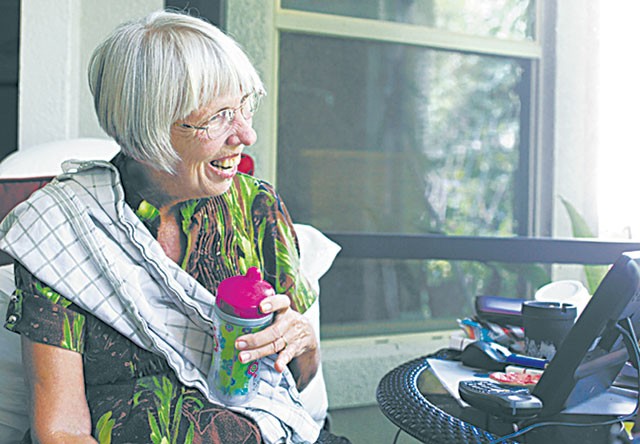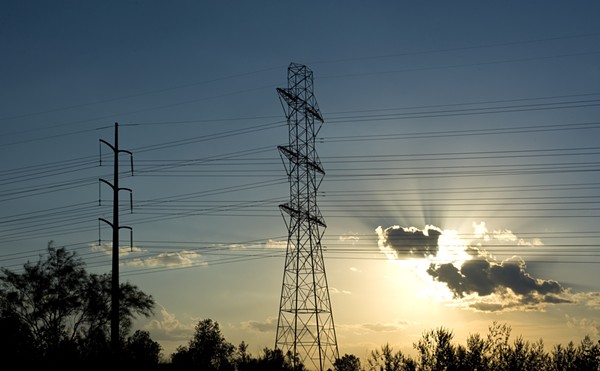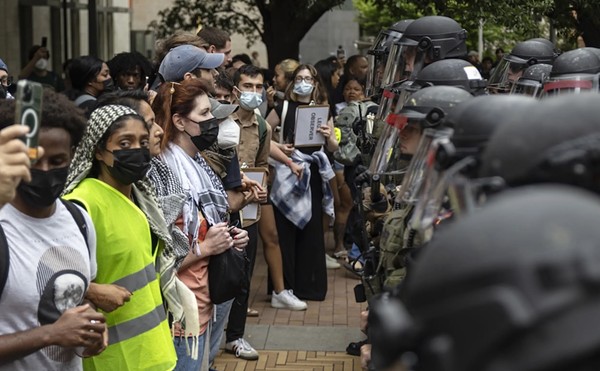When my beloved 17-year-old Persian cat was in pain, suffering from multiple diseases, I gave him the ultimate gift of love. I had him put to sleep, euthanized or, I suppose — semantics be damned — you could say I asked the vet to kill him, and she did. He died peacefully in my and my husband’s arms, while the vet administered a lethal dose of medicine. Family and friends all exclaimed it was the right thing to do; it was a humane act, Silver Surfer Dude was no longer suffering.
Fast-forward eight years or so, to last year, when two neurologists confirmed I had ALS, amyotrophic lateral sclerosis. Often known as Lou Gehrig’s disease, ALS is a fatal neuromuscular disease that slowly takes away your ability to walk, talk, eat, swallow, and speak; your mind remains intact, however, which means you get to watch your body die piece by piece until, mercifully, your respiratory muscles go and you finally get to die; this after having lost your independence and your dignity as well.
Oh, to be my beloved Persian! To be afforded a similarly peaceful, final exit from suffering. But the same folks who praise you for putting an animal out of its suffering have no qualms about forcing humans to live to the bitter end with a disease as hideous as ALS. Somehow, that just doesn’t make sense to me.
Even before I got my shocking second opinion, I began researching this horrid disease. And when I was done, my next step was to research death: Mine, on my own terms. I was going to die, period. The question was how: With some degree of dignity and control? Or a slow petering out of muscle, form, and function? Because there is no mystery about death with ALS. It is slow starvation, suffocation, and suffering.
I had no intention of putting myself, or my family, through such a despicable ending. And I certainly wasn’t depressed or suicidal — at least not at the time of my diagnosis. I wanted to live my life as much and as long as possible. But I also wanted to have control over my life, and part of life is death.
Those last words are the most important. The second sentence of the Declaration of Independence states: “We hold these truths to be self-evident, that all men are created equal, that they are endowed by their Creator with certain unalienable Rights, that among these are Life, Liberty and the pursuit of Happiness.”
So one of my unalienable rights is the right to life, which includes death, so I also have an unalienable right to die. Why, then, is American society (and law) so averse to this? I suspect the reasons are many, from religion to fear.
In the United States, death is feared in the same manner that youth and beauty are revered. Though it is a certitude that we all must deal with someday, we shy from discussing it, refuse to think about it, sometimes even avoid those who are facing it. We don’t know when we will die, or how, and it remains one of the few facets of life over which we have no control.
But what if we had control? What if we knew that if we ever ended up with a dreaded disease, such as Alzheimer’s or ALS, that we could ask to be put to sleep when we were ready? Wouldn’t that take away the fear, if we had control? My theory is that we are not afraid to die as much as we are afraid of how we will die, whether we will suffer or whether our family will suffer along with us for many years. So many people, usually starting around age 55-plus, say, “I just want to go fast” or “I hope I die in my sleep.” Those are words of fear. Fear of a horrible, slow, financially ruinous, bad death without recourse or control.
When you’re dying, it is interesting how many of your friends want to talk about death. And what they tell you in confidence is equally fascinating. I guess they feel safe you will take their secrets to the grave, pun intended. One friend admitted administering a lethal dose of hoarded morphine to his wife during the final months of her battle with a horrific disease; another said he has been hoarding narcotics for years, with plans to take them all someday if he ever faced a fatal disease. Others have plans for Europe, still others contemplate suicide just on the off chance that they might contract some awful disease. It is amazing how much thought is given to something that hasn’t even happened! That’s fear.
The West Coast, which as a rule tends to be more socially advanced than the rest of the U.S., has actually had public dialogue about death in its three states: Washington, Oregon, and California. As a result, the forward-thinking citizens of Oregon and Washington approved physician-assisted suicide (something of a misnomer, since it simply allows a doctor to prescribe a lethal dose; it’s up to the person to administer it). Californians voted against it. Neighboring Montana is a little different in that its legality resulted from a state supreme court case, Baxter v. Montana, in which the court ruled in 2009 that there is no law or legal precedent that precludes a physician from aiding a patient in dying.
Oregon and Washington named their laws beautifully: Death With Dignity acts. Of course, they have measures in place to protect Johnnie from killing off Grandma so that he can inherit early, and to protect those who are suicidal. Not just anyone can off themselves with the state’s seal of approval, either. You must meet certain criteria, such as having a terminal diagnosis. Most important, there is a residency requirement. (Wouldn’t look good for the chambers of commerce to have growth statistics like “3,000 moved here in July; 3,000 died here in July.”)
Despite all the hype that attends these public initiatives, reality is much less dramatic. Since Oregon passed its humane act in 1997, only 525 people have made use of it. The demographic makeup of the 65 people who availed themselves of it last year was older — 71 percent were over age 65 — and 79 percent had cancer.
In August 2004, the American Medical Association reported in its online journal of ethics, Virtual Mentor, that requests for physician-assisted suicide aren’t uncommon. “Of 100 ALS patients surveyed in Oregon and southwest Washington, 56 percent would consider [physician-assisted suicide] … Compared to other terminal diseases, those with ALS use assisted suicide and euthanasia at higher rates, as reported from jurisdictions where it is legal and statistics are available.”
So, good for the residents of those three states, and those terminally ill non-residents who have the foresight and wherewithal to uproot themselves and their families and head out west six months before they think their time is up so they are able to die on their own terms.
For the rest of us, there are few options. There’s that age-old favorite of Socrates’ — suicide by hemlock — but where is the dignity? Suicide is always messy, carries a huge stigma and is painful to the survivors. Worse, it has to be done solo, lest your loved ones get charged with murder. Where are the loving arms that ought to surround you at this intensely personal moment? They can’t be there; it’s too dangerous.
Yet for me, suicide is simply not an option. It is a pain I have lived with before; it is the route my husband took 31 years ago, the same one my schizophrenic daughter took 14 years ago, and the same way one of my oldest and dearest friends took a few years back. The pain their deaths left to those who loved them is incalculable.
Suicide is a deliberate, selfish act I would not wish on anyone: an act of sheer desperation. It almost always results from a disease, known collectively as mental illness, in one of many hideous forms. These are not people who were terminally ill with no hope for a cure, though I know their suffering was as great as that of a person dying of cancer. There is a very distinct difference between the cold, shocking, solo act of suicide and a planned, calm, rational death that takes place in a warm environment, surrounded by loved ones who support your decisions.
There’s always Europe, where the respect for life and death is alive in dozens of countries, such as Belgium. Fly over, check into a lovely room, order your death, and die peacefully on your own terms among loved ones. Well, it’s expensive, and it’s a long trip, plus you have to be capable of the rigors of traveling there, as well as paying to ship your body back home.
Then there is Final Exit Network, formerly known as the Hemlock Society, which will help you help yourself by providing pertinent information about a merciful, self-inflicted death. But even then, you have to be able to do the deed yourself. For many, especially those of us with ALS, you have to act early — while you still have use of your arms or legs. But at that stage, most of us aren’t hot on leaving so soon. Certainly not me — I love life. I love living so much that, even while I contemplate my options for death, I cannot conceive of taking my own life; it is that foreign to me. And yet, to die in the way that ALS has outlined for me is also inconceivable. How wonderful it would be to reach that stage when my quality of life is gone and say to my family and my doctor, “I’m ready now, please put me to sleep.”
But even talking about this, let alone trying to plan it, leads to suspicion. In a conversation with one social worker shortly after my diagnosis, my questions about end-of-life options were greeted with the narrowing of eyes, concerns about whether I was suicidal, and my understanding that a failure to convince her otherwise would lead to three days in the county mental health ward, courtesy of the Baker Act. Please, folks. We’re adults here. We have a fatal disease and we have every right to explore all of our options.
And yet, despite thinking about and researching death for more than a year, I’ve made a surprising discovery: I don’t want to go. Neither tomorrow nor next Wednesday, nor some day in December. Even as I lose more and more control of my body — and with that my independence — I convince myself at each new loss that this isn’t so bad, I still have _____ (whatever it is I still have).
What I’ve learned is that it’s easy to draw the line on what you will or won’t put up with, long before you get to that point. But as you get closer to that big day, the will to live is unbelievably strong. Not because you’re desperate for a cure, but simply because you want to wake up one more day and see the faces and hear the voices of those you love.
Will I always feel this way? Probably not. One person with end-stage ALS likened it to being buried alive. I am not looking forward to that. What I do want, and what I think most people want, is choices and the ability to make them in the most humane way possible for themselves and for the benefit of their loved ones.
Fortunately there is another way out, though not as neat and tidy. In 1990, in Cruzan v. Director, Missouri Department of Public Health, the U.S. Supreme Court recognized for the first time a constitutional right to refuse treatment in extraordinary circumstances. And in 1997, in Washington v. Glucksberg, the court found a similar guarantee of the right to refuse medical treatment. That goes for tube feedings, vents and any other life-saving measures that we do not want, including food and water. All that is required is a living will. And free will. And the guts to call it quits — the latter being the hardest part. •
Anne Johnson is longtime journalist, a former managing editor of the Jacksonville Business Journal and the Folio Weekly, where this story was first published. Her April 5 story about her diagnosis with ALS is available as a PDF at http://bit.ly/tjSj7s.



















